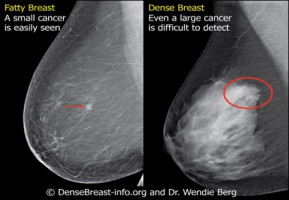
By Monique Biryiana
Increased breast density is associated with an increased risk of developing breast cancer, as mammograms are not as effective in detecting cancerous tumours within dense breast tissue.
Breast tissue can be categorised into four main types, depending on density. As all breasts comprise of glands, fibrous tissue and fat - dense breasts typically contain more glandular and fibrous tissue.
Dense breast tissue has a similar appearance to cancerous tumours, as they both appear white on mammograms. Therefore, this makes the detection of these tumours significantly difficult.
This is a major problem for women, especially in the UK, as the current screening guidelines solely rely upon mammograms - regardless of breast density status.
Other countries such as France and Austria have appropriate guidelines in place, specifically for women with dense breast tissue and offer additional screening procedures, such as ultrasound in combination with mammography.
It is imperative that women are aware of their breast density status and the associated risks, so they are able to consult with their healthcare providers on the most effective screening methods for them.
To read the full article, please click here.
Image credit: Ⓒ 2015 - 2019, DenseBreast-info.org